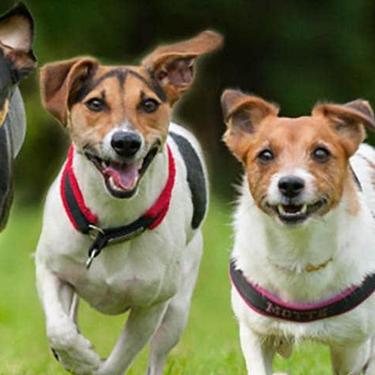
-
Find the right food for your petTake this quiz to see which food may be the best for your furry friend.Find the right food for your petTake this quiz to see which food may be the best for your furry friend.Featured products
 Adult Wet Dog Food with Beef
Adult Wet Dog Food with BeefHill's Science Plan Adult Multipack Wet Dog Food with Chicken, Beef & Turkey are complete premium pet foods for adult dogs from 1 year. Your dog will love these deliciously smooth and savoury minced loaves, formulated for balanced nutrition and overall health.
Shop Now Mature Adult Dog Food
Mature Adult Dog FoodHill's Science Plan Mature Adult Multipack Wet Dog Food with Chicken & Beef are complete premium pet foods for mature adult dogs from 7 years. Your dog will love these deliciously smooth and savoury minced loaves, formulated to deliver the appropriate amount of energy to support the needs of adult dogs.
Shop Now Puppy Food
Puppy FoodHill's Science Plan Puppy Multipack Wet Dog Food with Chicken & Beef are complete premium pet foods for growing puppies from weaning until 1 year old and for pregnant and nursing dogs. Your puppy will love these deliciously smooth and savoury minced loaves, formulated for balanced nutrition and overall health.
Shop NowFeatured products Light Adult Multipack Wet Cat Food with Chicken & Ocean Fish
Light Adult Multipack Wet Cat Food with Chicken & Ocean FishTender chicken chunks in gravy for cats, with L-carnitine and fewer calories for ideal weight management. Packed with high-quality protein, omega-6s, and vitamin E for shiny fur and healthy skin.
Shop Now Adult Multipack Wet Cat Food with Beef, Ocean Fish & Chicken
Adult Multipack Wet Cat Food with Beef, Ocean Fish & ChickenTender chunks in gravy for cats, with high-quality protein to maintain lean muscle. With vitamin E and omega-3s & -6s for healthy skin and balanced minerals to support healthy vital organs.
Shop Now Mature Adult Wet Cat Food with Chicken
Mature Adult Wet Cat Food with Chicken
Tender chicken chunks in gravy for mature adult cats. Made with easy-to-digest ingredients, high-quality protein for lean muscle maintenance and antioxidant vitamins C+E for optimal health.
Shop Now -
Dog
- Dog Tips & Articles
-
Health Category
- Weight
- Food & Environmental Sensitivities
- Urinary
- Digestive
- Joint
- Kidney
-
Life Stage
- Puppy Nutrition
- Adult Nutrition
- Senior Nutrition
Cat- Cat Tips & Articles
-
Health Category
- Weight
- Skin & Food Sensitivities
- Urinary
- Digestive
- Kidney
-
Life Stage
- Kitten Nutrition
- Adult Nutrition
Featured articles The Incredible Science Behind Your Pet's Microbiome
The Incredible Science Behind Your Pet's MicrobiomeLearn what your pet's microbiome is, how it contributes to your pet's gut and overall health, and why nutrition is important in maintaining healthy microbiomes.
Read More The Right Diet For Your Pet
The Right Diet For Your PetIn people, the right diet is very important. If you are eating the wrong way for your metabolism, activity level, age and lifestyle you could end up with health issues.
Read More Show some love with wet foods: a great choice for pets with health issues
Show some love with wet foods: a great choice for pets with health issuesShow some love with wet foods: a great choice for pets with health issues.
Read More -


The vast majority of the time, stretching is a totally normal and largely beneficial activity for dogs to do. There are several reasons they might stretch every day, and often lots of times. That said, in some cases stretching can be a sign of problems, and in rare cases it can be a sign of potentially life-threatening illness. So, you can see that it’s important to know when it’s good, when it’s something to keep an eye on, and when it’s an emergency.
Why do dogs stretch?
Virtually all animals, humans included, feel the urge to stretch our muscles at certain times. It feels great and often it’s almost a reflex action that we do with a big yawn. Well, dogs are the same. Here are the major reasons dogs stretch:
After lying down. Most dogs will have a nice, big stretch after they’ve been asleep or laid down for a while. This is a normal way to loosen muscles and get moving again. They may do it before bed, too.
The play bow. This is a signature move that dogs do that looks like a big stretch. It’s a way that dogs signal to each other that they’d like to play. The play bow is as it sounds - rump in the air, they flatten their front end to the floor with front legs stretched out in front. If the other dog replies similarly, let the games commence!
Boredom. When dogs are bored or under-stimulated, stretching may be a kind of displacement activity. This kind of stretching may be accompanied by attention-seeking behaviour like nudging you or putting their head on your lap expectantly. It’s time to get active with them. Even if you can’t take them for a walk, try to play a game in the house or garden or do a little training. Any mental or physical stimulation is good.
A pulled muscle or joint pain. Just like us, if your dog has pulled a muscle or is feeling stiff, they will stretch the affected area to try to loosen up and alleviate the pain. If you notice a certain area or limb being stretched more than usual, or your dog seems a little lame as they get moving, it may be a sign of arthritis or joint pain and a vet visit would be in order.


Tasty Tips
Abdominal pain. This is where stretching becomes incredibly important. Dogs with abdominal pain tend to stretch in a way that closely mimics the play bow - rump up, front end down, flat on the floor. The big difference is that they’ll do it when no other dogs are around, and they will often stay much longer than usual in this position. They may also cry in pain or shy away from being stroked or touched. Stretching or arching the back into a tucked-up posture may also be a sign of abdominal pain.
Abdominal pain is an incredibly important stretching cause to watch out for as it can be a sign of acute pancreatitis. This is a potentially fatal inflammation of the pancreas and is incredibly painful. Pancreatitis in dogs is often caused by a fatty meal, or after they’ve raided something out of the bin, but doesn’t always follow an obvious incident. Some breeds of dog, such as the cocker spaniel and schnauzer, are more prone to pancreatitis than others.
This really is a veterinary emergency, so if you ever suspect abdominal pain as the cause of your dog’s excessive stretching, seek veterinary attention as soon as you can. Every minute counts when it comes to pancreatitis.
Know what’s normal
It can’t be stressed enough how important it is to know what’s normal for your dog. The more observant you are to their daily behaviours, routines and quirks of personality, the sooner you will spot something odd and be able to act quickly. As ever, if you have any concerns at all, never hesitate to ask your vet. We would always rather be safe than sorry and after all, that’s what we are here for!
Reviewed by Dr. Hein Meyer, DVM, PhD, Dipl-ECVIM-CA


One of our staff authors prepared this article for you
Related products

Hill's Science Plan Adult Multipack Wet Dog Food with Chicken, Beef & Turkey are complete premium pet foods for adult dogs from 1 year. Your dog will love these deliciously smooth and savoury minced loaves, formulated for balanced nutrition and overall health.

Hill's Science Plan Mature Adult Multipack Wet Dog Food with Chicken & Beef are complete premium pet foods for mature adult dogs from 7 years. Your dog will love these deliciously smooth and savoury minced loaves, formulated to deliver the appropriate amount of energy to support the needs of adult dogs.

Hill's Science Plan Puppy Multipack Wet Dog Food with Chicken & Beef are complete premium pet foods for growing puppies from weaning until 1 year old and for pregnant and nursing dogs. Your puppy will love these deliciously smooth and savoury minced loaves, formulated for balanced nutrition and overall health.

Hill's Science Plan Hypoallergenic Adult Wet Dog Food with Salmon is a complete premium pet food for all adult dogs from 1 year. This savoury tinned loaf is specially formulated for dogs with delicate skin and stomachs. It features a single novel animal protein source and is grain-free.
Related articles

Learn about the potential health risks of a raw diet for dogs and why they aren't the best option for your pup or you.

Learn effective tips for feeding a dog that's a picky eater and ensure proper nutrition for a finicky eater. Discover tips for pet parents at Hill's Pet UK.

How, when and what to feed your new puppy is an important decision, learn more about the things to consider for feeding your puppy.

Many human foods are dangerous to dogs. Read about 5 of the worst toxic food offenders that can kill your dog - and how much it takes to hurt them.

Put your dog on a diet without them knowing
Our low calorie formula helps you control your dog's weight. It's packed with high-quality protein for building lean muscles, and made with purposeful ingredients for a flavourful, nutritious meal. Clinically proven antioxidants, Vitamin C+E, help promote a healthy immune system.
Put your dog on a diet without them knowing
Our low calorie formula helps you control your dog's weight. It's packed with high-quality protein for building lean muscles, and made with purposeful ingredients for a flavourful, nutritious meal. Clinically proven antioxidants, Vitamin C+E, help promote a healthy immune system.

